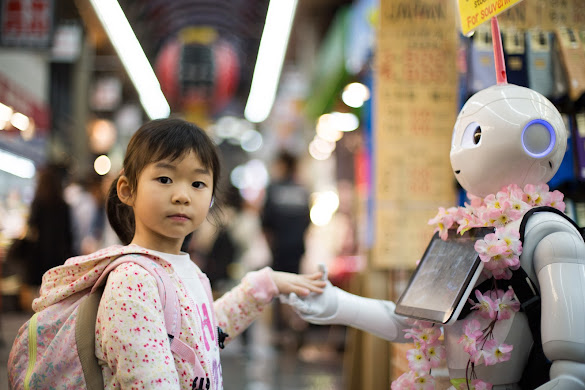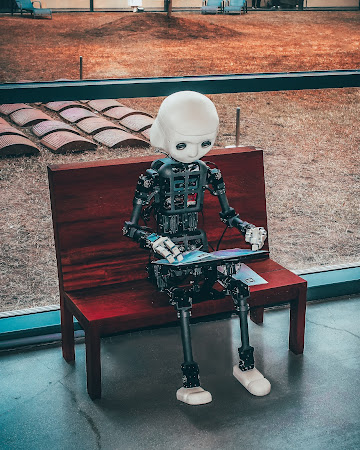The Decade of Artificial Intelligence
Despite this, this unstoppable technological achievement is often viewed and discussed with skepticism. Is this development really that different from the innovations of the last 50 years, which have become an integral part of our current life and society? Ingo Hoffmann, Managing Director of AI. Hamburg, explains why it is so important, especially for Europe, to accept and understand AI and, above all, to actively promote the use of machine learning (ML). Benedict Evans compared machine learning to the introduction of the relational database in the 1970s. A helpful comparison.
In the 1970s and 1980s, relational database models fundamentally changed the efficiency of data storage and thus the possibilities of software development. Few people recognized this at first. But the founders of SAP made use of this development. Companies like SAP or Amazon would not have come into being without a relational database. Today, relational databases are used by almost all companies - and often go unnoticed. We live in an information revolution that is just 50 years old and is based on innovations such as personal computers, databases, the internet, and smartphones. AI and machine learning create new ways of using data and software. AI not only brings us more efficiency - but additional intelligence. AI is not new, the first approaches already existed in the middle of the last century. The Dartmouth Conference of 1956 is considered the birth of artificial intelligence In particular, Deep Learning enables recognition of images and speech (Alexa, Siri) and in 2016 AlphaGo beat the world champion in Go - 10 years earlier than all experts expected.
AI now has the potential to change everything and optimize other technologies. New materials can and will be developed with AI. Our interaction with the environment and our working world is being changed by AI. Likewise, it will affect how we make decisions and govern society(ies). In healthcare and the fight against disease, AI will open up new avenues for us. In short, it will capture every single aspect of human existence and society. The foundations for the new (or new old) market leaders are laid during these years. For example, by 2025 Bosch in Germany wants to either develop its products with AI or they will contain AI. Analyzes and figures also prove the potential. In a study, PwC has shown that in 2030 additional growth of the global economy of US$ 15.7 trillion can be achieved through AI. For comparison: China has a gross domestic product of US$ 14.3 trillion in 2019.
The market for AI-based solutions will grow from almost US$60 billion in 2019 to US$158 billion in 2023 .
Many countries have created an AI strategy and planned investments to ensure their competitiveness and promote the development of AI. Germany has increased its AI investment in 2020 from €3 billion to €5 billion by 2025 and is launching a future fund of €10 billion for the next 10 years, with a focus on fast-growing startups and new technologies such as AI and BioTech China wants to become the leading AI nation worldwide by 2030 - in research, innovation, and applications. Billions of dollars are being invested nationally and regionally for this. The national figures have not been published, but 2 regions alone (Shanghai, Tianjin) have each planned US$ 15 billion in AI investments. Saudi Arabia wants to invest US$ 30 billion in AI by 2030. Even the USA, which has so far relied on the strength of its universities in AI research and private investments from Google, Amazon, Facebook, Apple, and Co.), is strengthening public AI investments. On January 1, 2021, within the framework of the National Defense Authorization Act, Congress also decided to demand around US$ 6.5 billion for AI in the non-military area. A lot is happening, but these developments are often difficult to recognize in everyday life.
We use AI every day with our smartphones (face recognition, Siri, and Alexa), Google search, or when shopping online (recommendations). This is so normal that we don't see AI anymore. On the other hand, AI is characterized by science fiction images (Terminator) or decried as a job killer (the robots take over all jobs). AI has not yet arrived in many companies. Since AI is not always a "visible" technology, such as smartphones, the possibilities in the world of work are only slowly becoming apparent. Many projects in companies are still tests, so-called proof of concepts. The topic of AI is often seen as hype, which is partly true. Gartner shows in the AI Hype Cycle that many AI technologies are currently at the peak of the hype, or are on the way to the valley of disillusionment. However, it is also becoming clear that in the next 2-5 years many of these technologies, such as machine learning, deep neural networks, chatbots, or computer vision, will reach the plateau of productivity. In the coming years, more and more AI-based solutions and companies will emerge that are superior to previous approaches. We can already see this in the area of B2C solutions today. Companies like Google, Amazon, Apple, and Facebook, and in China, Tencent and Alibaba are leaders in the use (and further development) of AI. Your market success is essentially based on the strategic use of AI in all areas. They have thus become the most valuable companies (by market value) in the world and the best examples of the winners of the internet AI wave. Kai-Fu Lee, a well-known AI researcher, and current investor, has identified four waves of AI adaptation in his 2018 book “AI Superpowers”: First Wave: Internet AI Second Wave: Business AI Third Wave: Perception AI Fourth Wave: Autonomous AI The first wave was based on the use of consumer data, for example for recommendations in online shops, search engines, or personalized marketing. This wave is behind us. Here the cards are taken, the lead of the companies in the USA and China cannot be caught up. The second wave is on the move and is based on the use of company data. There are still no clear winners here and Europe has good chances of developing successful companies here. The third wave builds on the previous two and adds the real world – by using sensors and the ability of AI to “see”, “hear” and “understand” speech.
From personal AI assistants to intelligent factories. We are at the beginning of this wave, which can play a decisive role for Europe and our industry. The fourth wave brings autonomous systems and machines. This is where the greatest potential and the greatest changes for the industry and our everyday lives lie. (Author's side note: "Kai-Fu Lee is very skeptical about AI development in Europe. He primarily sees China and the USA as the winners. I don't agree with him! But we have to use the potential in Europe now. "). All of this will evolve over the next 10 years. We are dealing with exponential growth. Data is the basis for the productive use of AI. In the coming years, the amount of data available will grow exponentially. IDC predicts that 175 zettabytes of data will be produced in 2025 (compared to 2018: 33 zettabytes). Of that, 90 zettabytes will come from smart sensors. 75% of the world's population will interact with data every day, triggering an interaction every 18 seconds. Combined with the increasingly productive AI technologies (see Gartner Hype Cycle) that will be available in the next few years, this will lead to an exponential increase in AI-based applications. We have not yet taken into account that AI research is also developing rapidly, driven by large investments in industrialized countries. Many AI technologies that will be used in 10 years have not yet been "invented". But only the AI possibilities known today will make the developments described here possible in this decade. This results in a fantastic potential for investors to invest in future market leaders. It shows the need for companies of all industries and sizes to deal with the topic and potential of AI. And better to actively use it today than tomorrow. New business models will emerge. Entrepreneurship is becoming more important than ever. New jobs are created, and cooperation between humans and AI is becoming the norm. As a society, we need to better understand the opportunities and changes AI brings and how we deal with it. New risks arise for companies, users, and societies. These must be recognized and addressed. New regulations will be needed, but these should not restrict the innovation potential of AI from the outset.




.jpg)
Comments
Post a Comment